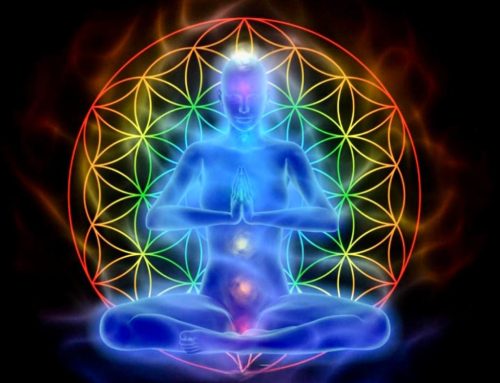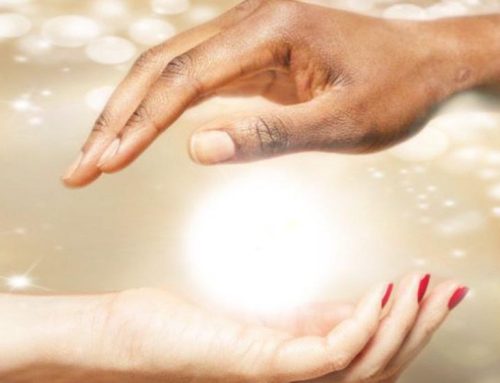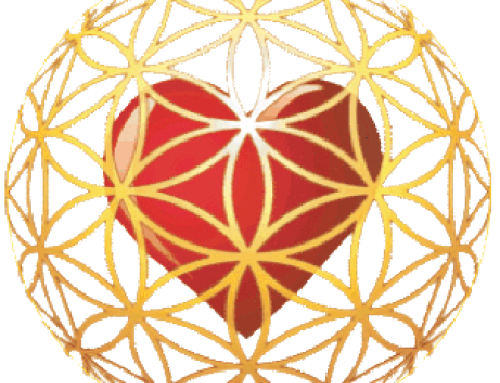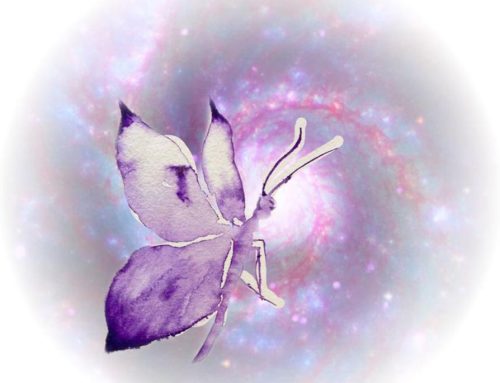The chakras are commonly described as energy centers that correspond to various organs and nerves in the body. This is a starting point for understanding. However, they are much more. As the North Indian scholar Harish Johari describes in his book Chakras: Energy Centers of Transformation, the chakras are psychic centers of transformation that allow one to move towards a state of enlightenment. Chakra is a Sanskrit word meaning wheel, disk, or any circular arrangement; also indicates movement. In fact, Johari explains that the chakras introduce movement because they “transform psychophysical energy into spiritual energy.”
Energy (known as prana in the yogic tradition) flows through the chakras. When a body is in balance, energy flows freely and can be energizing, revitalizing, and peaceful. There are seven main chakras located along an energetic channel called the sushumna nadi, which runs through the base of the spine through the crown of the head, passing through each of the chakras on its way. The chakras act as junction points between your human form and consciousness.
First Chakra-Muladhara
The first chakra, Muladhara, is located at the base of the spine and is associated with the element of earth and the color red. Known as the razi chakra, it is connected to courage and self-care, as well as stability.
In balance: Balance in the first chakra allows you to feel grounded and confident.
Altered: Excess energy in this chakra leads to greed and arrogance.
Signs of Insufficiency: Low energy in this chakra can leave you feeling upset or disconnected from your work, family, and your true self.
Second Chakra-Svadhisthana
The second chakra is called the Svadhisthana or the sacral chakra. It is located in the pelvic area. Here in the West, it is known as the charka of creativity, as well as the chakra associated with sexual desire (or lack thereof). Its color is orange and its element is water. Creativity and pleasure come from this energy center.
In balance: Balance in the second chakra allows you to feel comfortable in your own skin and accept your emotions. It also allows for creative expression of the self.
Altered: When the sacral chakra is over-energized, you can look beyond your faults and become hyper-focused on pleasure. It can lead to overindulgence and co-dependency.
Signs of insufficiency: Lack of energy can lead to creative blocks, feeling unloved, and emotional roller coasters.
Third Chakra-Manipura
The third chakra, Manipura, is associated with personal power, energy, and transformation. Its color is yellow and its element is fire.
In Balance: Balance in the third chakra is indicated by high self-esteem, strong charisma, and confident decision-making.
Altered: When the energy of this chakra is too high, tempers can flare and you may feel the need to control everything and everyone.
Signs of failure: Low energy can lead to poor appetite, anxiety, disorganization, and difficulty staying on task.

The chakras are commonly described as energy centers that correspond to various organs and nerves in the body. This is a starting point for understanding. However, they are much more. As the North Indian scholar Harish Johari describes in his book Chakras: Energy Centers of Transformation, the chakras are psychic centers of transformation that allow one to move towards a state of enlightenment. Chakra is a Sanskrit word meaning wheel, disk, or any circular arrangement; also indicates movement. In fact, Johari explains that the chakras introduce movement because they “transform psychophysical energy into spiritual energy.”
Energy (known as prana in the yogic tradition) flows through the chakras. When a body is in balance, energy flows freely and can be energizing, revitalizing, and peaceful. There are seven main chakras located along an energetic channel called the sushumna nadi, which runs through the base of the spine through the crown of the head, passing through each of the chakras on its way. The chakras act as junction points between your human form and consciousness.
First Chakra-Muladhara
The first chakra, Muladhara, is located at the base of the spine and is associated with the element of earth and the color red. Known as the razi chakra, it is connected to courage and self-care, as well as stability.
In balance: Balance in the first chakra allows you to feel grounded and confident.
Altered: Excess energy in this chakra leads to greed and arrogance.
Signs of Insufficiency: Low energy in this chakra can leave you feeling upset or disconnected from your work, family, and your true self.
Second Chakra-Svadhisthana
The second chakra is called the Svadhisthana or the sacral chakra. It is located in the pelvic area. Here in the West, it is known as the charka of creativity, as well as the chakra associated with sexual desire (or lack thereof). Its color is orange and its element is water. Creativity and pleasure come from this energy center.
In balance: Balance in the second chakra allows you to feel comfortable in your own skin and accept your emotions. It also allows for creative expression of the self.
Altered: When the sacral chakra is over-energized, you can look beyond your faults and become hyper-focused on pleasure. It can lead to overindulgence and co-dependency.
Signs of insufficiency: Lack of energy can lead to creative blocks, feeling unloved, and emotional roller coasters.
Third Chakra-Manipura
The third chakra, Manipura, is associated with personal power, energy, and transformation. Its color is yellow and its element is fire.
In Balance: Balance in the third chakra is indicated by high self-esteem, strong charisma, and confident decision-making.
Altered: When the energy of this chakra is too high, tempers can flare and you may feel the need to control everything and everyone.
Signs of failure: Low energy can lead to poor appetite, anxiety, disorganization, and difficulty staying on task.


The chakras are commonly described as energy centers that correspond to various organs and nerves in the body. This is a starting point for understanding. However, they are much more. As the North Indian scholar Harish Johari describes in his book Chakras: Energy Centers of Transformation, the chakras are psychic centers of transformation that allow one to move towards a state of enlightenment. Chakra is a Sanskrit word meaning wheel, disk, or any circular arrangement; also indicates movement. In fact, Johari explains that the chakras introduce movement because they “transform psychophysical energy into spiritual energy.”
Energy (known as prana in the yogic tradition) flows through the chakras. When a body is in balance, energy flows freely and can be energizing, revitalizing, and peaceful. There are seven main chakras located along an energetic channel called the sushumna nadi, which runs through the base of the spine through the crown of the head, passing through each of the chakras on its way. The chakras act as junction points between your human form and consciousness.
First Chakra-Muladhara
The first chakra, Muladhara, is located at the base of the spine and is associated with the element of earth and the color red. Known as the razi chakra, it is connected to courage and self-care, as well as stability.
In balance: Balance in the first chakra allows you to feel grounded and confident.
Altered: Excess energy in this chakra leads to greed and arrogance.
Signs of Insufficiency: Low energy in this chakra can leave you feeling upset or disconnected from your work, family, and your true self.
Second Chakra-Svadhisthana
The second chakra is called the Svadhisthana or the sacral chakra. It is located in the pelvic area. Here in the West, it is known as the charka of creativity, as well as the chakra associated with sexual desire (or lack thereof). Its color is orange and its element is water. Creativity and pleasure come from this energy center.
In balance: Balance in the second chakra allows you to feel comfortable in your own skin and accept your emotions. It also allows for creative expression of the self.
Altered: When the sacral chakra is over-energized, you can look beyond your faults and become hyper-focused on pleasure. It can lead to overindulgence and co-dependency.
Signs of insufficiency: Lack of energy can lead to creative blocks, feeling unloved, and emotional roller coasters.
Third Chakra-Manipura
The third chakra, Manipura, is associated with personal power, energy, and transformation. Its color is yellow and its element is fire.
In Balance: Balance in the third chakra is indicated by high self-esteem, strong charisma, and confident decision-making.
Altered: When the energy of this chakra is too high, tempers can flare and you may feel the need to control everything and everyone.
Signs of failure: Low energy can lead to poor appetite, anxiety, disorganization, and difficulty staying on task.
Antes del tratamiento

Después del tratamiento

Fourth Chakra-Ahahata
Perhaps the most familiar chakra is the heart chakra, Ahahata. Its color is green and its element is air. It is deeply associated with love, compassion, forgiveness, and peace.
In Balance: When energy flows freely, you will experience compassion, love, and acceptance.
Disturbed: If you experience jealousy or feel clingy, you may have too much energy in your heart.
Signs of Insufficiency: Signs that your heart chakra may be blocked or low on energy include feeling shy or lonely, or experiencing an inability to forgive.
Fifth Chakra-Vishuddha
The Vishuddha or throat chakra is your center of expression, associated with speaking your truth. Its element is akasha, which is a Sanskrit word meaning space or pure potentiality. The color associated with Vishuddha is blue.
In Balance: When the throat chakra is in balance, you feel authentic and are a confident conversationalist and good listener.
Altered: If you know the expression “all stuck,” then you understand what too much throat chakra energy can sound like: emotional overload. It is also associated with manipulative behavior, arrogance, and being overly talkative.
Signs of failure: When throat energy is low, there may be a tendency to feel shy or reticent or to act passive-aggressively.
Sixth Chakra-Ajna
The sixth chakra is located in the center of the forehead, the third eye. This is the Ajna chakra. Your decisions, intuition and choice are connected to this chakra, whose associated color is purple.
In Balance: Ajna means “beyond wisdom,” and in balance you experience expanded imagination, clairvoyance, synchronicity, and insight.
Altered: When the third eye chakra is hyperactive, the mind races. You can feel that fuzzy energy from over caffeine or from insomnia. It can be hard to focus or stay on task.
Signs of insufficiency: Low or blocked Ajna energy impedes your ability to remember and focus. Processing speed is reduced and you may be prone to procrastination and indecision.
Seventh Chakra-Sahaswara
The seventh chakra is called the Sahaswara or crown chakra. It is your connection to your source, spirit, or the collective consciousness. Its color is white or ultraviolet.
In Balance: In balance, this chakra maintains your self-awareness, wisdom, and connection to the inner compass that guides you to your highest self.
Altered: Signs of too much crown energy include materialism and rigid self-identity.
Signs of inadequacy: Low crown energy leads to depression, a sense of disconnection from life, and a lack of compassion.
Chakra Balancing
In Person and Online: $75
To book a session, please click on the service inquiry button and fill out the short form.









 Bienvenido a “Un puente entre el cielo y la tierra”. En este espacio quiero compartir las herramientas que me han llevado a conocerme cada día un poco más en la Plenitud del Ser. El Amor y la Paz que vivo, que Soy, que extiendo, no son de este mundo, pero cada uno de nosotros lo lleva grabado en sus células. Y la captamos en esta dimensión cuando la dejamos surgir de lo más profundo, cuando abrimos nuestro corazón y dejamos que ancle y despliegue nuestra Esencia. Te invito a conocerte en toda tu Luz.
Bienvenido a “Un puente entre el cielo y la tierra”. En este espacio quiero compartir las herramientas que me han llevado a conocerme cada día un poco más en la Plenitud del Ser. El Amor y la Paz que vivo, que Soy, que extiendo, no son de este mundo, pero cada uno de nosotros lo lleva grabado en sus células. Y la captamos en esta dimensión cuando la dejamos surgir de lo más profundo, cuando abrimos nuestro corazón y dejamos que ancle y despliegue nuestra Esencia. Te invito a conocerte en toda tu Luz.